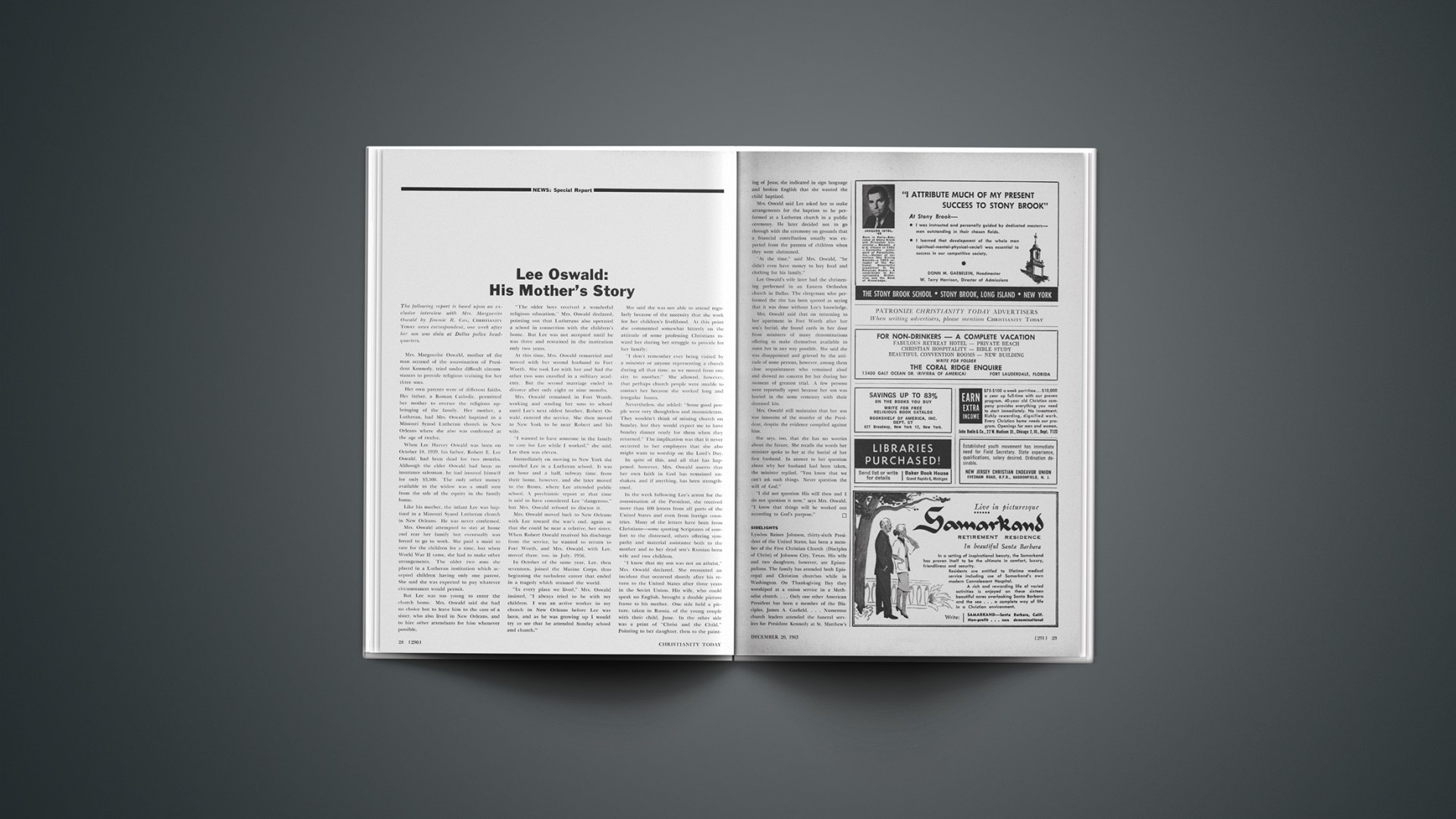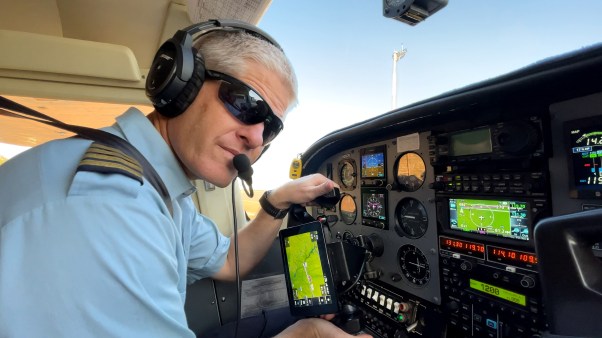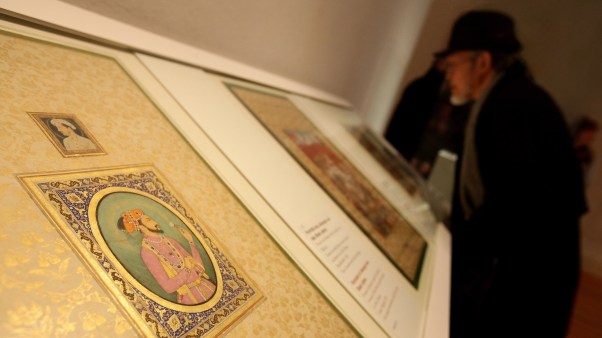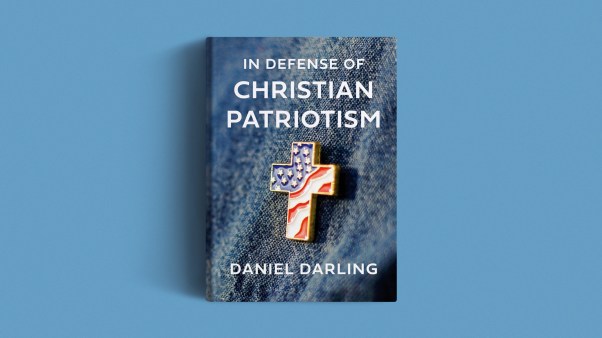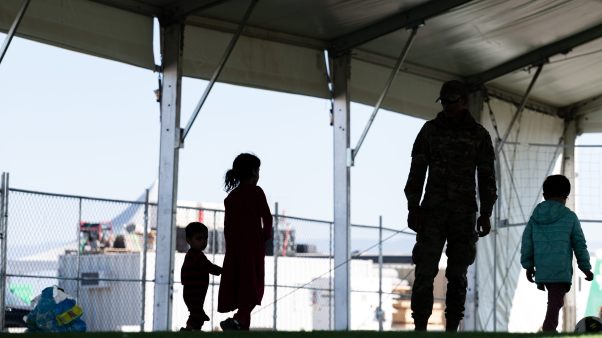The following report is based upon an exclusive interview with Mrs. Marguerite Oswald by Jimmie R. Cox, CHRISTIANITY TODAYnews correspondent, one week after her son was slain at Dallas police headquarters.
Mrs. Marguerite Oswald, mother of the man accused of the assassination of President Kennedy, tried under difficult circumstances to provide religious training for her three sons.
Her own parents were of different faiths. Her father, a Roman Catholic, permitted her mother to oversee the religious upbringing of the family. Her mother, a Lutheran, had Mrs. Oswald baptized in a Missouri Synod Lutheran church in New Orleans where she also was confirmed at the age of twelve.
When Lee Harvey Oswald was born on October 18, 1939, his father, Robert E. Lee Oswald, had been dead for two months. Although the elder Oswald had been an insurance salesman, he had insured himself for only $3,500. The only other money available to the widow was a small sum from the sale of the equity in the family home.
Like his mother, the infant Lee was baptized in a Missouri Synod Lutheran church in New Orleans. He was never confirmed.
Mrs. Oswald attempted to stay at home and rear her family but eventually was forced to go to work. She paid a maid to care for the children for a time, but when World War II came, she had to make other arrangements. The older two sons she placed in a Lutheran institution which accepted children having only one parent. She said she was expected to pay whatever circumstances would permit.
But Lee was too young to enter the church home. Mrs. Oswald said she had no choice but to leave him to the care of a sister, who also lived in New Orleans, and to hire other attendants for him whenever possible.
“The older boys received a wonderful religious education,” Mrs. Oswald declared, pointing out that Lutherans also operated a school in connection with the children’s home. But Lee was not accepted until he was three and remained in the institution only two years.
At this time, Mrs. Oswald remarried and moved with her second husband to Fort Worth. She took Lee with her and had the other two sons enrolled in a military academy. But the second marriage ended in divorce after only eight or nine months.
Mrs. Oswald remained in Fort Worth, working and sending her sons to school until Lee’s next oldest brother. Robert Oswald, entered the service. She then moved to New York to be near Robert and his wife.
“I wanted to have someone in the family to care for Lee while I worked,” she said. Lee then was eleven.
Immediately on moving to New York she enrolled Lee in a Lutheran school. It was an hour and a half, subway time, from their home, however, and she later moved to the Bronx, where Lee attended public school. A psychiatric report at that time is said to have considered Lee “dangerous.” but Mrs. Oswald refused to discuss it.
Mrs. Oswald moved back to New Orleans with Lee toward the war’s end, again so that she could be near a relative, her sister. When Robert Oswald received his discharge from the service, he wanted to return to Fort Worth, and Mrs. Oswald, with Lee, moved there, too, in July, 1956.
In October of the same year, Lee, then seventeen, joined the Marine Corps, thus beginning the turbulent career that ended in a tragedy which stunned the world.
“In every place we lived,” Mrs. Oswald insisted, “I always tried to be with my children. I was an active worker in my church in New Orleans before Lee was born, and as he was growing up I would try to see that he attended Sunday school and church.”
She said she was not able to attend regularly because of the necessity that she work for her children’s livelihood. At this point she commented somewhat bitterly on the attitude of some professing Christians toward her during her struggle to provide for her family:
“I don’t remember ever being visited by a minister or anyone representing a church during all that time, as we moved from one city to another.” She allowed, however, that perhaps church people were unable to contact her because she worked long and irregular hours.
Nevertheless, she added: “Some good people were very thoughtless and inconsiderate. They wouldn’t think of missing church on Sunday, but they would expect me to have Sunday dinner ready for them when they returned.” The implication was that it never occurred to her employers that she also might want to worship on the Lord’s Day.
In spite of this, and all that has happened, however, Mrs. Oswald asserts that her own faith in God has remained unshaken, and if anything, has been strengthened.
In the week following Lee’s arrest for the assassination of the President, she received more than 400 letters from all parts of the United States and even from foreign countries. Many of the letters have been from Christians—some quoting Scriptures of comfort to the distressed, others offering sympathy and material assistance both to the mother and to her dead son’s Russian-born wife and two children.
“I know that my son was not an atheist,” Mrs. Oswald declared. She recounted an incident that occurred shortly after his return to the United States after three years in the Soviet Union. His wife, who could speak no English, brought a double picture frame to his mother. One side held a picture, taken in Russia, of the young couple with their child, June. In the other side was a print of “Christ and the Child.” Pointing to her daughter, then to the painting of Jesus, she indicated in sign language and broken English that she wanted the child baptized.
Mrs. Oswald said Lee asked her to make arrangements for the baptism to be performed at a Lutheran church in a public ceremony. He later decided not to go through with the ceremony on grounds that a financial contribution usually was expected from the parents of children when they were christened.
“At the time,” said Mrs. Oswald, “he didn’t even have money to buy food and clothing for his family.”
Lee Oswald’s wife later had the christening performed in an Eastern Orthodox church in Dallas. The clergyman who performed the rite has been quoted as saying that it was done without Lee’s knowledge.
Mrs. Oswald said that on returning to her apartment in Fort Worth after her son’s burial, she found cards in her door from ministers of many denominations offering to make themselves available to assist her in any way possible. She said she was disappointed and grieved by the attitude of some persons, however, among them close acquaintances who remained aloof and showed no concern for her during her moment of greatest trial. A few persons were reportedly upset because her son was buried in the same cemetery with their deceased kin.
Mrs. Oswald still maintains that her son was innocent of the murder of the President, despite the evidence compiled against him.
She says, too, that she has no worries about the future. She recalls the words her minister spoke to her at the burial of her first husband. In answer to her question about why her husband had been taken, the minister replied, “You know that we can’t ask such things. Never question the will of God.”
“I did not question His will then and I do not question it now,” says Mrs. Oswald. “I know that things will be worked out according to God’s purpose.”
Sidelights
Lyndon Baines Johnson, thirty-sixth President of the United States, has been a member of the First Christian Church (Disciples of Christ) of Johnson City, Texas. His wife and two daughters, however, are Episcopalians. The family has attended both Episcopal and Christian churches while in Washington. On Thanksgiving Day they worshiped at a union service in a Methodist church.… Only one other American President has been a member of the Disciples, James A. Garfield.… Numerous church leaders attended the funeral services for President Kennedy at St. Matthew’s Cathedral. Prominent clergymen included evangelist Billy Graham and integration leader Martin Luther King.… Britons flocked to churches on hearing the news of the assassination. Religious News Service reported from England: “It is safe to say that there was not a church, chapel or synagogue in this land in which there were not special prayers—in some cases special services—in which the worshippers paid tribute to the late President”.… The Bible upon which President Johnson placed his hand as he was sworn into office may have been a Douay Roman Catholic version. U. S. District Court Judge Sarah T. Hughes, who administered the oath, recalled that “I thought someone said it was a Catholic Bible”.… Only two weeks before he was elevated to the Presidency, Johnson cited Psalm 91 as his favorite Bible passage. He quoted the entire chapter in reply to a query from a New Jersey teen-ager.… The minister who presided at the burial service for Lee Harvey Oswald was the Rev. Louis A. Saunders, executive secretary of the Fort Worth Area Council of Churches. He is a clergyman of the Disciples of Christ. He went to the cemetery on his own and was called to officiate at the last moment after an out-of-town minister, through a reported misunderstanding, failed to appear. Having had no time to prepare, and having even left his Bible in his car parked two blocks away, Saunders began: “We have come here today to lay away the body of Lee Harvey Oswald. We are not here to judge him but to bury him. May God have mercy on his soul.” The clergyman then turned to newsmen and security men and said Mrs. Oswald had asked him to say that Lee was a good son to her, a good husband to his wife, and a good father.
Last Call For Tax Benefits?
American church-goers who put extra dollars in the offering plate by December 31 may get some income tax relief.
Contributions made before the end of 1963 will be deductible from gross income that is taxed at the 1963 rate, and present indications in Washington are that 1964 income tax rates will be a little lower. Thus, a charitable gift will not be worth as much in 1964 in terms of tax saving as one made this year.
Under present tax rates, a contribution to a religious, educational, or charitable institution means a tax saving of from 20 cents to 91 cents on the dollar, depending on the taxpayer’s bracket. The tax reduction bill which passed the House of Representatives in September sets rates 16 cents to 77 cents per dollar.
Congress, facing an election year in 1964, is believed almost certain to pass a tax bill, especially since President Johnson has made it the first plank of his legislative program and has promised Congress an effort to reduce expenditures and bring the budget into earlier balance.
It is believed that there is only a remote chance that the Senate would restore to the bill a provision recommended by the late President Kennedy that would allow any kind of deductions only to the extent that together they exceed 5 per cent of an individual’s income.
Even if this provision is rejected by the Senate, as it was in the House, there is a possibility that donations will be tax deductible only if they exceed $50 for an individual or $100 for a married couple.
Adjournment
Amid speculation that Pope Paul VI may not be as progressive as many have thought, the Second Vatican Council adjourned until next fall.
The pontiff issued a personal decree that made permanent certain transitory rights and privileges of Roman Catholic bishops, but left the big question of the collegiality of the bishops still unresolved. He took the edge off some of the liberals’ disappointment by announcing plans for a visit to the Holy Land next month.
Decrees were promulgated on liturgy and communications. They represent the only two of the seventeen schemata on the council’s agenda that have been completed. Both were approved by overwhelming votes.
Mapping Out Mapilindo
A fragile cultural federation in Southeast Asia embracing a combined population of 140 million spells opportunity for a group of Protestant evangelists. They feel that the loose association of Malaysia, Pilipinas (native spelling for the Philippines), and Indonesia provides a favorable climate for more effective proclamation of the Christian message. They have appropriated the term “Mapilindo” and are busy organizing an evangelistic strategy for the three countries.
The term “Mapilindo” was created by the chiefs of state of what was formerly Malaya (now Malaysia), the Philippines, and Indonesia during a summit conference in Manila last July. The federation still stands, despite the highly problematical attitudes of Indonesia and the Philippines toward the formation of Malaysia. The common racial beginnings of the three date back to the ancient Madjapahit Empire.
First step in the Mapilindo evangelistic plan will be a conference for Christian leaders in Singapore next August. Plans will be set in motion for the appointment of Mapilindo gospel teams comprising one evangelist each from Malaysia, Pilipinas, and Indonesia. The idea grew out of an early-morning prayer meeting among a group of concerned evangelical workers in Singapore last summer.
Much of the impetus for the new strategy came from Philippine evangelist Gregorio Tingson, a product of both Oriental and Occidental education. A former law student at the University of the Philippines, Tingson was sent to the United States following World War II by an American Christian serviceman who had heard him preach. Tingson had been converted to Christianity under the influence of Miss May Coggins, an American Baptist missionary now living in Phoenix, Arizona. While in the States, he studied at Olivet College of the Church of the Nazarene in Kankakee, Illinois.
Since his return to the Philippines, Tingson has taken yearly evangelistic tours through parts of Asia. His latest, this year, saw him in Hong Kong, Bangkok, Calcutta, Madras, Colombo, and Singapore.
It was the consensus of those at the Singapore prayer meeting that while the word “Mapilindo” is basically an appellation for the cultural federation of the three nations, the same word may yet serve as a strong rallying point for the cause of evangelism in that part of the world. A number of church leaders have voiced support. They believe that with the common aboriginal bond and racial affinity among the Mapilindo people, the formation of Mapilindo gospel teams will push ahead the cause of Asian evangelism significantly.
The teams could mean much, especially in Malaysia, where reportedly there is not a single native Malay Christian. The British government some years ago caused to be included in the Malayan constitution a provision prohibiting foreign missionaries from doing evangelistic work among the native Malays. The Christians found in Malaya are either Chinese, Japanese, Indian, or some other non-Malay nationality.
Evangelical observers in the Mapilindo region feel that the Mapilindo gospel teams may hold the answer to reaching the native Malays. A person from the Philippines or Indonesia has physical characteristics very similar to the native Malays.
The Mapilindo region as a whole counts only three million evangelical Christians out of the 140 million population (100 million in Indonesia, 30 million in the Philippines, and 10 million in Malaysia).
EUSTAQUIO RAMIENTOS, JR.

